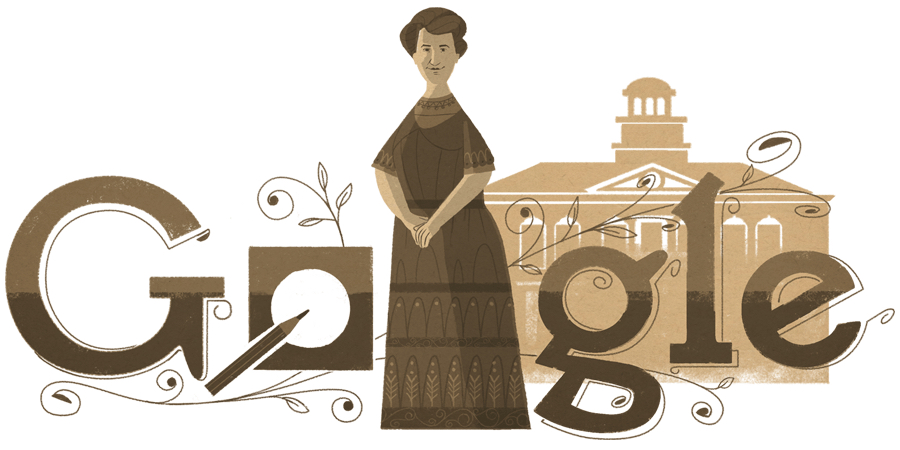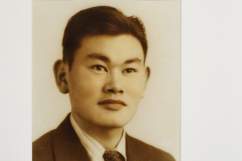
(Google)
Dutch physician, suffragist and inventor Aletta Jacobs is being celebrated with a Google Doodle on what would have been her 163rd birthday.
“Aletta Jacobs was a woman of many firsts. Growing up in the Netherlands in the 1800s, she watched the profound impact her father, a doctor, had on his patients’ lives,” Google says. “She longed to do the same, but she knew it wouldn’t be easy – no Dutch woman had ever studied medicine. Jacobs didn’t let that stop her.”
“Today, on what would’ve been Jacobs’ 163rd birthday, we celebrate all that she did to pave the way for those who came after her,” Google says.
Jacobs was a “pioneer in many realms—birth control, women’s suffrage, peace activism, and envisioning a wider future for women,” the Jewish Women’s Archive says.
Here’s what you need to know about Aletta Jacobs:
1. Jacobs Was Born in a Small Village in the Netherlands & Wasn’t Allowed to Attend High School

(Wikimedia Commons)
Aletta Henriëtte Jacobs was born February 9, 1854, in the small village of Sappemeer in the Netherlands.
Because she was a woman, Jacobs was not allowed to attend high school, and had to pursue her educational interests on her own, according to AlettaJacobs.org.
Jacobs was the eighth child of a Jewish doctor’s family. Her parents were Anna De Jongh and Abraham Jacobs. While she was a teenager, she learned French, German, Latin and Greek from her father.
2. She Graduated From Amsterdam University as the First Female Physician in the Netherlands
In 1869, Jacobs took the admission examination to become a pharmacist’s assistant, but was denied. A year later, she took an again exam to enter the University of Groningen and was accepted on a temporary basis, according to AlettaJacobs.org.
She had to receive special permission from the government to attend.
After two years studying there, she was admitted full-time. She went on to study at Amsterdam University, and in 1878 completed her medical degree. She earned her medical doctorate a year later, becoming the first female physician in the Netherlands.
Along with her medical studies, her interest in social justice issues was also awakened at university.
“During these years Jacobs became concerned with social injustice,” the biography says. “Among other things, she learned how absurd the Dutch marriage laws were.”
Jacobs was married, to a politician and activist.
“A small and slender woman, she married Carel Victor Gerritsen, a Dutch grain merchant, legislator and reformer, in 1892, after a long acquaintance,” according to the Jewish Women’s Archive encyclopedia. “They enjoyed an egalitarian relationship, their otherwise happy and productive life together marred only by one devastating loss: the child they longed for lived only a day.”
3. After College, Jacobs Set Up a Clinic for the Lower Class & Worked to Make Contraceptives More Available to Women

Aletta Jacobs. (Wikimedia Commons)
After graduating from Amsterdam University, Jacobs moved to London, because she “read in British women’s magazines about how professors, doctors, and students were actively sabotaging women’s attempts to study medicine in England,” according to AlettaJacobs.org.
She soon returned to Amsterdam, where she began a small practice in Amsterdam, renting rooms from a widow. Jacobs’ clinic aimed to provide medical care to the lower class who were unable to afford it.
Jacobs learned about new developments in contraceptives while in London, and also wanted to use her clinic to provide those contraceptives to women. Some say her practice was the first free birth control clinic, according to Google.
In her autobiography, “Memories: My Life as an International Leader in Health, Suffrage, and Peace,” Jacobs wrote about that cause:
For social, moral, and medical reasons, women from different social classes had often asked me for some form of contraception. I had always had to fend off these requests without providing adequate explanation or advice. Eventually I sent letters to a number of women whose need was greatest. I told them that I believed I had found a means to help them, but before I could fully recommend it, they would have to agree to regular examinations during the first months of its use. Some of these women eventually agreed to the experiment, and the results were such that, some months later, I was able to announce that I could provide a safe and effective contraceptive.
Her birth control efforts received criticism from Dutch religious and political leaders.
The clinic opened more than “30 years before those in the United States and Britain. Her success inspired the activities of other birth-control advocates and Margaret Sanger and Marie Stopes both traveled to the Netherlands to find out more about the work of Jacobs,” according to Spartacus Educational.
According to the Jewish Women’s Archive, “She set up her medical practice in Amsterdam and began to have a significant impact on women’s health. She introduced the pessary (diaphragm) to the Netherlands despite intense opposition from male colleagues, held a free clinic for poor women two mornings a week, and campaigned to change the unhealthy working conditions of salesgirls.”
4. She Attended the International Council of Women’s Meeting in London in 1899 & Decided to Devote Her Life to Women’s Suffrage & World Peace
Jacobs attended the International Council of Women’s Meeting in London in 1899, and decided after that point to retire as a physician and devote the remainder of her life to women’s suffrage and other causes, including pacifism, according to the Jewish Women’s Archive.
She founded the Woman Suffrage Alliance in Amsterdam and was the first president of the organization, working along with the National Woman Suffrage Association and the National Union of Suffrage Societies. She helped create the International Woman Suffrage Alliance along with feminists from the United States, Britain, Sweden, Denmark, Australia and Germany.
In 1911, she went on a fact-finding mission along with Carrie Chapman Catt, touring several countries, including South Africa, Syria,Egypt, Indian, Burma, Singapore, the Dutch East Indies, the Philippines, CHina and Japan, according to Spartacus Educational.
After the start of World War I, she held an International Congress of Women at the Hague, the Jewish Women’s Archive’s encyclopedia says:
Jacobs strove to use her international network to try to stop the slaughter. With a small group of planners, she called for an international women’s conference at the Hague and invited the acclaimed American reformer Jane Addams to chair the proceedings. Despite the resistance of governments and the hazards of wartime travel, a resilient group of women from belligerent and neutral nations convened at the Hague from April 28 to May 1, 1915, and passed farsighted resolutions. Jacobs participated in one of the two small post-conference delegations, her group traveling through a war-obsessed Europe, meeting with leaders of the belligerent nations to encourage mediation. In September 1915 she voyaged to the United States in an unsuccessful attempt to persuade President Woodrow Wilson to mediate the conflict.
“Women will soon have political power. Woman suffrage and permanent peace will go together. When a country is in a state of mind to grant the vote to its women, it is a sign that that country is ripe for permanent peace,” Jacobs wrote. “Women don’t feel as men do about war. They are the mothers of the race. Men think of the economic results, women think of the grief and pain.”
5. Jacobs Died in 1929 at the Age of 75
Aletta Jacobs died on August 19, 1929, in Baarn, Netherlands while visiting her friend and fellow suffragist Rosa Manus.
She was married, but did not have any children. Her husband, a politician and pacifist Carel Victor Gerritsen, died in 1905.
Jacobs continued to speak and work for peace and women’s rights up until her death.
“Her health weakened and her finances straitened, she spent her later years in close contact with her dear friends the Broese van Groenous, still traveling to conferences and speaking her mind, and receiving honors and appreciation from Dutch women and from abroad,” the Jewish Women’s Archive says.
Jacobs is fondly remembered in the Netherlands, and was honored with a statue outside of Groningen University, where she studied.
Another school she attended, the Austrian Secondary School in Sappemeer, was renamed for her in 1949. It is called dr. Aletta Jacobs College to this day.



